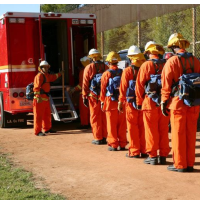Upon Review, the State Won’t Use Violent Offenders in Prison to Fight Fires

If only fires could be snuffed out as fast as ill-conceived ideas by prison officials to fight them.
One week after California Department of Corrections and Rehabilitation (CDCR) spokesman Bill Sessa told the Sacramento Bee and other media outlets about a plan to fill a shortfall in firefighting inmates by using violent offenders, the idea was temporarily shelved.
“We need to rethink that,” Sessa told Bee reporter Jon Ortiz.
The Conservation Camp program, run by the CDCR and the California Department of Forestry and Fire Protection (Cal Fire), trains more than 4,300 inmates for work combating fires in the state. But they are all low-level felons. Murderers, rapists, robbers and child abusers (among the 23 categories of serious felony) need not apply.
They are a critical part of the state’s firefighting effort, and are more important than ever in the age of drought and intensified fire seasons. Unfortunately, the state has released a lot of low-level felons the past four years to reduce prison overcrowding and is running out of cheap labor to fight fires.
Inmates receive $1 an hour and time-served credit for the work. They are also utilized in other emergencies, including floods and earthquakes, and work on conservation projects on public lands and local community services projects.
The CDCR says on its website that the state saves $80 million a year by using cheap Conservation Camp labor. BuzzFeed calculated it is closer to $1 billion. The state didn’t want to pay either price hiring replacement labor.
That became shockingly evident last November when the Los Angeles Times noted that lawyers for Attorney General Kamala Harris argued in court that firefighting inmates shouldn’t be able to take advantage of court orders to offer more inmates work-earned parole.
Reporter Paige St. John wrote that they argued “if forced to release these inmates early, prisons would lose an important labor pool.”
The CDCR is right that the prison labor pool Cal Fire draws firefighters from is dwindling. It’s possible the state will have to actually recruit and train regular workers to do the tough and dangerous job—and pay them accordingly.
But that doesn’t seem to be the plan for now. The state is going to clean up some of the “confusion and misunderstanding” surrounding the proposal and give it another shot later. They want to reclassify inmates who were imprisoned for serious offenses as nonviolent felons if they have stayed out of trouble.
But prison officials promise to be thorough in their evaluations and very selective in who would be eligible to fight fires. They wouldn’t want anyone dangerous walking away from a minimum-security fire camp facility.
–Ken Broder
To Learn More:
State Reverses Plan to Have Violent Offenders Fight Fires (by Jon Ortiz, Sacramento Bee)
California May Change Rules So They Can Keep Fighting Fires with Prison Labor (by Alan Pyke, ThinkProgress)
Violent Offenders Could Join Fire Camps Next Year (by Jon Ortiz, Sacramento Bee)
Thousands of Inmates Still Fighting Fires Despite Early Release of Low-Level Felons (by Ken Broder, AllGov California)
- Top Stories
- Controversies
- Where is the Money Going?
- California and the Nation
- Appointments and Resignations
- Unusual News
- Latest News
- California Forbids U.S. Immigration Agents from Pretending to be Police
- California Lawmakers Urged to Strip “Self-Dealing” Tax Board of Its Duties
- Big Oil’s Grip on California
- Santa Cruz Police See Homeland Security Betrayal in Use of Gang Roundup as Cover for Immigration Raid
- Oil Companies Face Deadline to Stop Polluting California Groundwater





